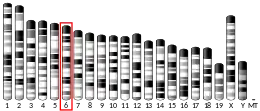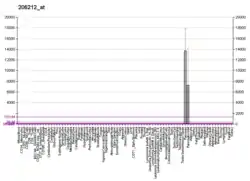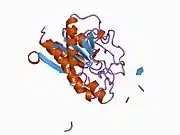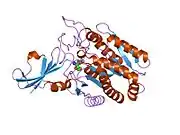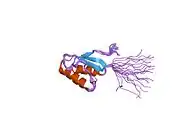| CPA2 | |||||||||||||||||||||||||||||||||||||||||||||||||||
|---|---|---|---|---|---|---|---|---|---|---|---|---|---|---|---|---|---|---|---|---|---|---|---|---|---|---|---|---|---|---|---|---|---|---|---|---|---|---|---|---|---|---|---|---|---|---|---|---|---|---|---|
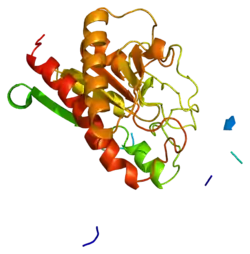 | |||||||||||||||||||||||||||||||||||||||||||||||||||
| |||||||||||||||||||||||||||||||||||||||||||||||||||
| Identifiers | |||||||||||||||||||||||||||||||||||||||||||||||||||
| Aliases | CPA2, carboxypeptidase A2 | ||||||||||||||||||||||||||||||||||||||||||||||||||
| External IDs | OMIM: 600688 MGI: 3617840 HomoloGene: 37541 GeneCards: CPA2 | ||||||||||||||||||||||||||||||||||||||||||||||||||
| |||||||||||||||||||||||||||||||||||||||||||||||||||
| |||||||||||||||||||||||||||||||||||||||||||||||||||
| |||||||||||||||||||||||||||||||||||||||||||||||||||
| |||||||||||||||||||||||||||||||||||||||||||||||||||
| |||||||||||||||||||||||||||||||||||||||||||||||||||
| Wikidata | |||||||||||||||||||||||||||||||||||||||||||||||||||
| |||||||||||||||||||||||||||||||||||||||||||||||||||
Carboxypeptidase A2 is an enzyme that in humans is encoded by the CPA2 gene.[5][6][7]
Three different forms of human pancreatic procarboxypeptidase A have been isolated. The A1 and A2 forms are monomeric proteins with different biochemical properties. The A2 form of pancreatic procarboxypeptidase acts on aromatic C-terminal residues[7]
References
- 1 2 3 GRCh38: Ensembl release 89: ENSG00000158516 - Ensembl, May 2017
- 1 2 3 GRCm38: Ensembl release 89: ENSMUSG00000071553 - Ensembl, May 2017
- ↑ "Human PubMed Reference:". National Center for Biotechnology Information, U.S. National Library of Medicine.
- ↑ "Mouse PubMed Reference:". National Center for Biotechnology Information, U.S. National Library of Medicine.
- ↑ Catasus L, Vendrell J, Aviles FX, Carreira S, Puigserver A, Billeter M (Apr 1995). "The sequence and conformation of human pancreatic procarboxypeptidase A2. cDNA cloning, sequence analysis, and three-dimensional model". J Biol Chem. 270 (12): 6651–7. doi:10.1074/jbc.270.12.6651. PMID 7896805.
- ↑ Hayashida S, Yamasaki K, Asada Y, Soeda E, Niikawa N, Kishino T (Aug 2000). "Construction of a physical and transcript map flanking the imprinted MEST/PEG1 region at 7q32". Genomics. 66 (2): 221–5. doi:10.1006/geno.2000.6206. PMID 10860668.
- 1 2 "Entrez Gene: CPA2 carboxypeptidase A2 (pancreatic)".
Further reading
- Pascual R, Burgos FJ, Salva M, et al. (1989). "Purification and properties of five different forms of human procarboxypeptidases". Eur. J. Biochem. 179 (3): 609–16. doi:10.1111/j.1432-1033.1989.tb14590.x. PMID 2920728.
- Laethem RM, Blumenkopf TA, Cory M, et al. (1996). "Expression and characterization of human pancreatic preprocarboxypeptidase A1 and preprocarboxypeptidase A2". Arch. Biochem. Biophys. 332 (1): 8–18. doi:10.1006/abbi.1996.0310. PMID 8806703.
- García-Sáez I, Reverter D, Vendrell J, et al. (1998). "The three-dimensional structure of human procarboxypeptidase A2. Deciphering the basis of the inhibition, activation and intrinsic activity of the zymogen". EMBO J. 16 (23): 6906–13. doi:10.1093/emboj/16.23.6906. PMC 1170294. PMID 9384570.
- Reverter D, García-Sáez I, Catasús L, et al. (1998). "Characterisation and preliminary X-ray diffraction analysis of human pancreatic procarboxypeptidase A2". FEBS Lett. 420 (1): 7–10. doi:10.1016/S0014-5793(97)01476-2. PMID 9450539. S2CID 7781802.
- Reverter D, Fernández-Catalán C, Baumgartner R, et al. (2000). "Structure of a novel leech carboxypeptidase inhibitor determined free in solution and in complex with human carboxypeptidase A2". Nat. Struct. Biol. 7 (4): 322–8. doi:10.1038/74092. PMID 10742178. S2CID 24225493.
- Wouters MA, Husain A (2002). "Changes in zinc ligation promote remodeling of the active site in the zinc hydrolase superfamily". J. Mol. Biol. 314 (5): 1191–207. doi:10.1006/jmbi.2000.5161. PMID 11743734.
- Strausberg RL, Feingold EA, Grouse LH, et al. (2003). "Generation and initial analysis of more than 15,000 full-length human and mouse cDNA sequences". Proc. Natl. Acad. Sci. U.S.A. 99 (26): 16899–903. Bibcode:2002PNAS...9916899M. doi:10.1073/pnas.242603899. PMC 139241. PMID 12477932.
- Jiménez MA, Villegas V, Santoro J, et al. (2003). "NMR solution structure of the activation domain of human procarboxypeptidase A2". Protein Sci. 12 (2): 296–305. doi:10.1110/ps.0227303. PMC 2312417. PMID 12538893.
- Dantas G, Kuhlman B, Callender D, et al. (2003). "A large scale test of computational protein design: folding and stability of nine completely redesigned globular proteins". J. Mol. Biol. 332 (2): 449–60. CiteSeerX 10.1.1.66.8110. doi:10.1016/S0022-2836(03)00888-X. PMID 12948494.
- Gerhard DS, Wagner L, Feingold EA, et al. (2004). "The status, quality, and expansion of the NIH full-length cDNA project: the Mammalian Gene Collection (MGC)". Genome Res. 14 (10B): 2121–7. doi:10.1101/gr.2596504. PMC 528928. PMID 15489334.
- Dantas G, Corrent C, Reichow SL, et al. (2007). "High-resolution structural and thermodynamic analysis of extreme stabilization of human procarboxypeptidase by computational protein design". J. Mol. Biol. 366 (4): 1209–21. doi:10.1016/j.jmb.2006.11.080. PMC 3764424. PMID 17196978.
External links
- The MEROPS online database for peptidases and their inhibitors: M14.002
- Overview of all the structural information available in the PDB for UniProt: P48052 (Human Carboxypeptidase A2) at the PDBe-KB.
This article is issued from Wikipedia. The text is licensed under Creative Commons - Attribution - Sharealike. Additional terms may apply for the media files.


